wheel MAZDA MODEL 3 HATCHBACK 2020 (in English) User Guide
[x] Cancel search | Manufacturer: MAZDA, Model Year: 2020, Model line: MODEL 3 HATCHBACK, Model: MAZDA MODEL 3 HATCHBACK 2020Pages: 598, PDF Size: 89.37 MB
Page 73 of 598

Never use a rear-facing child-restraint
system in the front seat with an air bag
that could deploy:
Rear-facing child-restraint systems on the
front seat are particularly dangerous even
though you may feel assured that a front
passenger air bag will not deploy based on
the fact that the front passenger air bag
deactivation indicator light illuminates.
The child-restraint system can be hit by a
deploying air bag and moved violently
backward resulting in serious injury or
death to the child.
Do not sit too close to the driver and front
passenger air bags:
Sitting too close to the driver and front
passenger air bag modules or placing
hands or feet on them is extremely
dangerous. The driver and front passenger
air bags inflate with great force and speed.
Serious injuries could occur if someone is
too close. The driver should always hold
onto only the rim of the steering wheel. The
front seat passenger should keep both feet
on the floor. Front seat occupants should
adjust their seats as far back as possible
and always sit upright against the
seatbacks with seat belts worn properly.
Sit in the center of the seat and wear seat
belts properly:
Sitting too close to the side air bag modules
or placing hands on them, or sleeping up
against the door or hanging out the
windows is extremely dangerous. The side
and curtain air bags inflate with great force
and speed directly expanding along the
door on the side the car is hit. Serious injury
could occur if someone is sitting too close
to the door or leaning against a window, or
if rear seat occupants grab the sides of the
front seatbacks. Give the side and curtain
air bags room to work by sitting in the
center of the seat while the vehicle is
moving with seat belts worn properly.
Do not attach objects on or around the
area where driver and front passenger air
bags deploy:
Attaching an object to the driver and front
passenger air bag modules or placing
something in front of them is dangerous. In
an accident, an object could interfere with
air bag inflation and injure the occupants.
Do not attach objects on or around the
area where a side air bag deploys:
Attaching objects to the front seat in such a
way as to cover the outboard side of the
seat in any way is dangerous. In an
accident the object could interfere with the
side air bag, which inflates from the
outboard side of the front seats, impeding
the added protection of the side air bag
system or redirecting the air bag in a way
that is dangerous. Furthermore, the bag
could be cut open releasing the gas.
Essential Safety Equipment
SRS Air Bags
2-57
Mazda3_8HZ1-EA-19G_Edition1_old 2019-5-17 13:49:03
Page 74 of 598
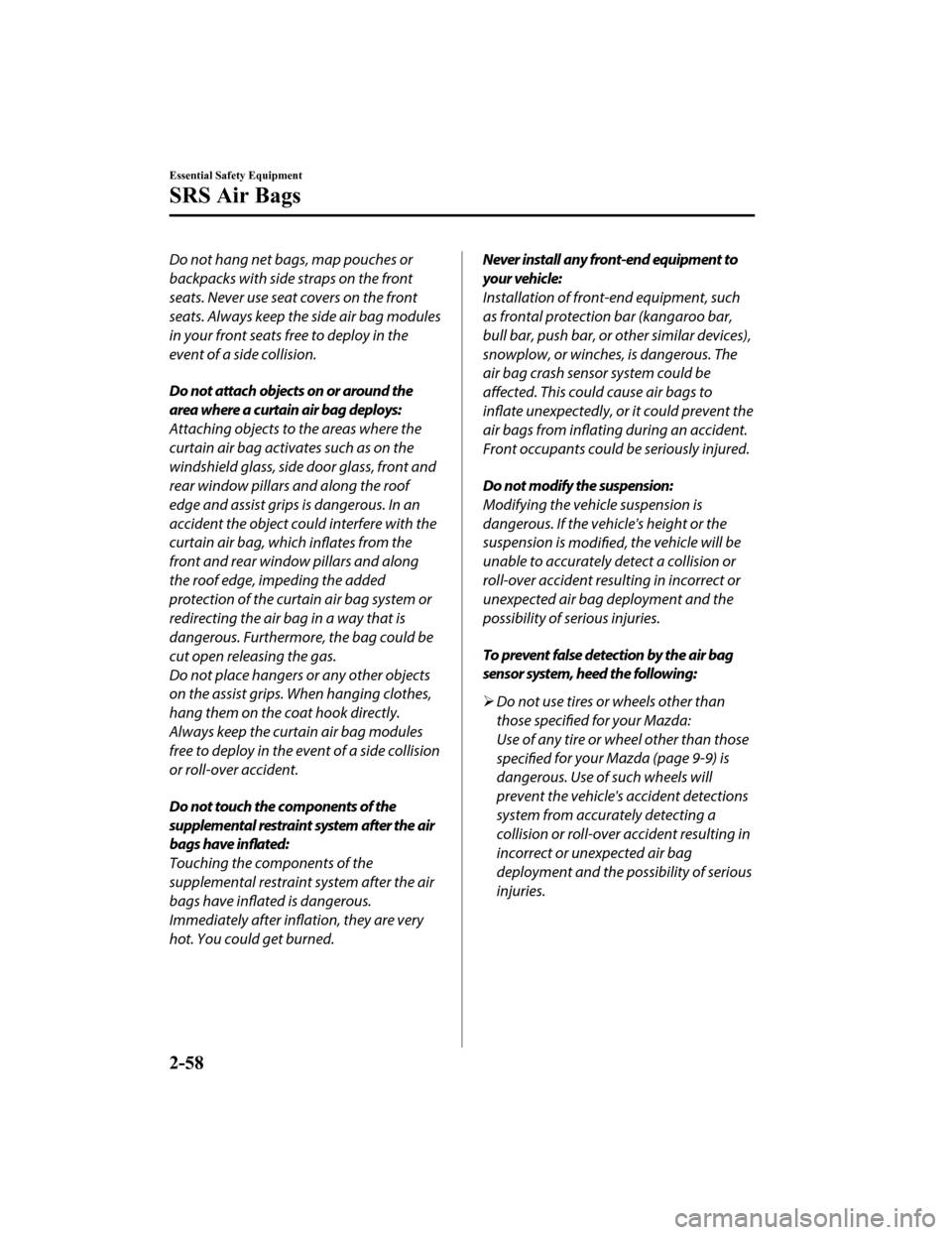
Do not hang net bags, map pouches or
backpacks with side straps on the front
seats. Never use seat covers on the front
seats. Always keep the side air bag modules
in your front seats free to deploy in the
event of a side collision.
Do not attach objects on or around the
area where a curtain air bag deploys:
Attaching objects to the areas where the
curtain air bag activates such as on the
windshield glass, side door glass, front and
rear window pillars and along the roof
edge and assist grips is dangerous. In an
accident the object could interfere with the
curtain air bag, which inflates from the
front and rear window pillars and along
the roof edge, impeding the added
protection of the curtain air bag system or
redirecting the air bag in a way that is
dangerous. Furthermore, the bag could be
cut open releasing the gas.
Do not place hangers or any other objects
on the assist grips. When hanging clothes,
hang them on the coat hook directly.
Always keep the curtain air bag modules
free to deploy in the event of a side collision
or roll-over accident.
Do not touch the components of the
supplemental restraint system after the air
bags have inflated:
Touching the components of the
supplemental restraint system after the air
bags have inflated is dangerous.
Immediately after inflation, they are very
hot. You could get burned.Never install any front-end equipment to
your vehicle:
Installation of front-end equipment, such
as frontal protection bar (kangaroo bar,
bull bar, push bar, or other similar devices),
snowplow, or winches, is dangerous. The
air bag crash sensor system could be
affected. This could cause air bags to
inflate unexpectedly, or it could prevent the
air bags from inflating during an accident.
Front occupants could be seriously injured.
Do not modify the suspension:
Modifying the vehicle suspension is
dangerous. If the vehi cle's height or the
suspension is modified, the vehicle will be
unable to accurately detect a collision or
roll-over accident resulting in incorrect or
unexpected air bag deployment and the
possibility of serious injuries.
To prevent false detection by the air bag
sensor system, heed the following:
Do not use tires or wheels other than
those
specified for your Mazda:
Use of any tire or wheel other than those specified for your Mazda (page 9-9) is
dangerous. Use of such wheels will
prevent the vehicle's accident detections
system from accurately detecting a
collision or roll-over accident resulting in
incorrect or unexpected air bag
deployment and the possibility of serious
injuries.
Essential Safety Equipment
SRS Air Bags
2-58
Mazda3_8HZ1-EA-19G_Edition1_old 2019-5-17 13:49:03
Page 76 of 598
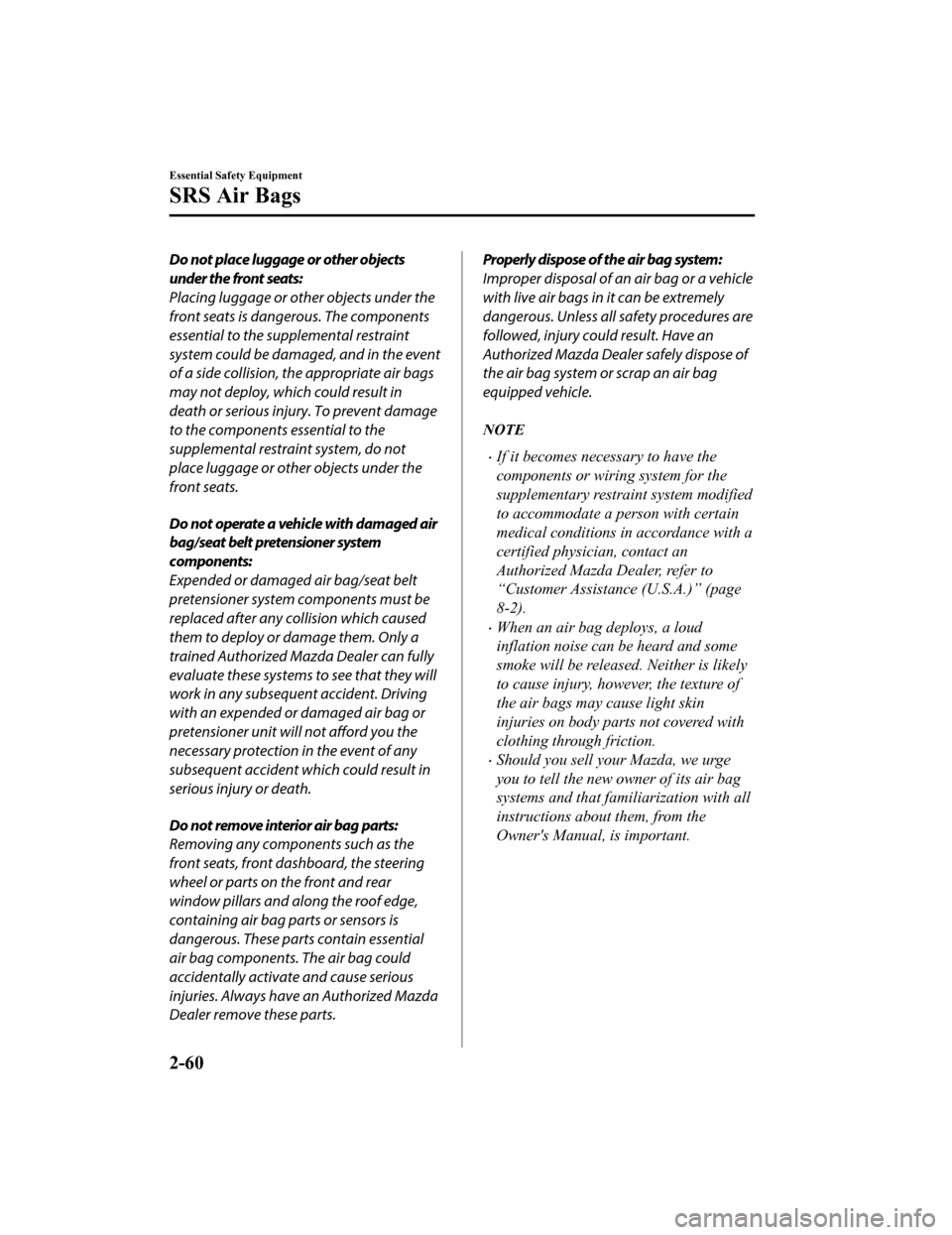
Do not place luggage or other objects
under the front seats:
Placing luggage or other objects under the
front seats is dangerous. The components
essential to the supplemental restraint
system could be damaged, and in the event
of a side collision, the appropriate air bags
may not deploy, which could result in
death or serious injury. To prevent damage
to the components essential to the
supplemental restraint system, do not
place luggage or other objects under the
front seats.
Do not operate a vehicle with damaged air
bag/seat belt pretensioner system
components:
Expended or damaged air bag/seat belt
pretensioner system components must be
replaced after any collision which caused
them to deploy or damage them. Only a
trained Authorized Mazda Dealer can fully
evaluate these systems to see that they will
work in any subsequent accident. Driving
with an expended or damaged air bag or
pretensioner unit will not afford you the
necessary protection in the event of any
subsequent accident which could result in
serious injury or death.
Do not remove interior air bag parts:
Removing any components such as the
front seats, front dashboard, the steering
wheel or parts on the front and rear
window pillars and al ong the roof edge,
containing air bag parts or sensors is
dangerous. These parts contain essential
air bag components. The air bag could
accidentally activate and cause serious
injuries. Always have an Authorized Mazda
Dealer remove these parts.Properly dispose of the air bag system:
Improper disposal of an air bag or a vehicle
with live air bags in it can be extremely
dangerous. Unless all safety procedures are
followed, injury could result. Have an
Authorized Mazda Deal er safely dispose of
the air bag system or scrap an air bag
equipped vehicle.
NOTE
If it becomes necessary to have the
components or wiring system for the
supplementary restraint system modified
to accommodate a person with certain
medical conditions in accordance with a
certified physician, contact an
Authorized Mazda Dealer, refer to
“Customer Assistance (U.S.A.)” (page
8-2).
When an air bag deploys, a loud
inflation noise can be heard and some
smoke will be released. Neither is likely
to cause injury, however, the texture of
the air bags may cause light skin
injuries on body parts not covered with
clothing through friction.
Should you sell your Mazda, we urge
you to tell the new owner of its air bag
systems and that familiarization with all
instructions about them, from the
Owner's Manual, is important.
Essential Safety Equipment
SRS Air Bags
2-60
Mazda3_8HZ1-EA-19G_Edition1_old 2019-5-17 13:49:03
Page 80 of 598

How the SRS Air BagsWo r k
▼How the SRS Air Bags Work
Your Mazda is equipped with the
following types of SRS air bags. SRS air
bags are designed to work together with
the seat belts to help to reduce injuries
during an accident.
The SRS air bags are designed to provide
further protection for passengers in
addition to the seat belt functions. Be sure
to wear seat belts properly.
▼Front Seat Bel
t Pretensioners
The front seat belt pretensioners are
designed to deploy in moderate or severe
frontal, near frontal collisions.
In addition, the pretensioners operate
when a side collision or a roll-over
accident is detected. The pretensioners
operate differently depending on what
types of air bags are equipped. For more
details about seat belt pretensioner
operation, refer to the SRS Air Bag
Deployment Criteria (page 2-68).
▼Driver Air Bag
The driver's air bag is mounted in the
steering wheel.
When air bag crash sensors detect a frontal
impact of greater than moderate force, the
driver's air bag inflates quickly helping to
reduce injury mainly to the driver's head
or chest caused by directly hitting the
steering wheel.
For more details about air bag
deployment, refer
to "SRS Air Bag
Deployment Criteria" (page 2-68).
(With Front Passenger Occupant
Classification System)
The driver's dual-stag e air bag controls air
bag inflation in two energy stages. During
an impact of moderate severity, the
driver's air bag deploys with lesser energy,
whereas during more severe impacts, it
deploys with more energy.
Essential Safety Equipment
SRS Air Bags
2-64
Mazda3_8HZ1-EA-19G_Edition1_old 2019-5-17 13:49:03
Page 86 of 598
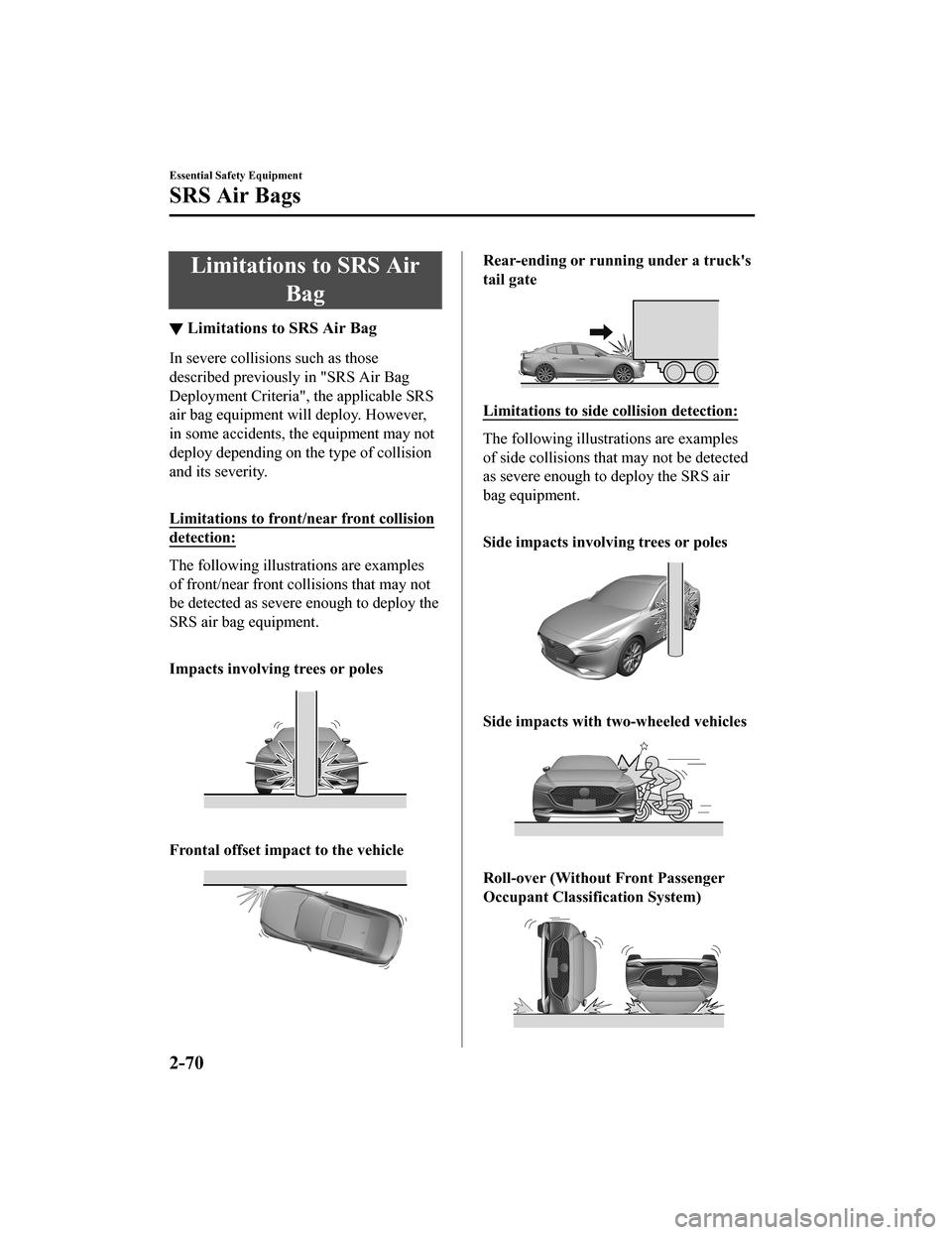
Limitations to SRS AirBag
▼Limitations to SRS Air Bag
In severe collisions such as those
described previousl
y in "SRS Air Bag
Deployment Criteria", the applicable SRS
air bag equipment will deploy. However,
in some accidents, the equipment may not
deploy depending on the type of collision
and its severity.
Limitations to front/near front collision
detection:
The following illustrations are examples
of front/near front collisions that may not
be detected as severe enough to deploy the
SRS air bag equipment.
Impacts involving trees or poles
Frontal offset imp act to the vehicle
Rear-ending or running under a truck's
tail gate
Limitations to side collision detection:
The following illustrations are examples
of side collisions that may not be detected
as severe enough to deploy the SRS air
bag equipment.
Side impacts involving trees or poles
Side impacts with two-wheeled vehicles
Roll-over (Without Front Passenger
Occupant Classification System)
Essential Safety Equipment
SRS Air Bags
2-70
Mazda3_8HZ1-EA-19G_Edition1_old 2019-5-17 13:49:03
Page 87 of 598

Limitations to roll-over detection (With
Front Passenger Occupant
Classification System):
The following illustration is an example of
an accident that may not be detected as a
roll-over accident. Therefore, the front
seat belt pretensioners and curtain air bags
may not deploy.
Pitch end over end
Driver and Front
Passenger Occupant
Classification System
*
▼ Driver and Front Passenger
Occupant Classification System
First, please read "Supplemental Restraint
System (SRS) Precau
tions" (page 2-55)
carefully.
▼ Driver Seat Slide Position Sensor
Your vehicle is equipped with a driver seat
slide position sensor as a part of the
supplemental restrain
t system. The sensor
is located under the driver seat.
The sensor determines whether the driver
seat is fore or aft of a reference position
and sends the seat position to the
diagnostic module (SAS unit).
The SAS unit is designed to control the
deployment of the driver air bag
depending on how close the driver seat is
to the steering wheel.
The air bag/front seat belt pretensioner
system warning light flashes if the sensor
has a possible malfunction (page 2-67).
Essential Safety Equipment
SRS Air Bags
*Some models.2-71
Mazda3_8HZ1-EA-19G_Edition1_old 2019-5-17 13:49:03
Page 136 of 598

Break-In Period
▼Break-In Period
No special break-in is necessary, but a few
precautions in the first 1,000 km (600
miles) may add to
the performance,
economy, and life of the vehicle.
Do not race the engine.
Do not maintain one constant speed,
either slow or fast, for a long period of
time.
Do not drive constantly at full-throttle or
high engine rpm for e xtended periods of
time.
Avoid unnecessary hard stops.
Avoid full-throttle starts.
Saving Fuel and Protection of the Environment
▼Saving Fuel and Protection of the
Environment
How you operate your Mazda determines
how far it will travel
on a tank of fuel. Use
these suggestions to help save fuel and
reduce CO
2.
Avoid long warm-ups. Once the engine
runs smoothly, begin driving.
Avoid fast starts.
Drive at lower speeds.
Anticipate when to apply the brakes
(avoid sudden braking).
Follow the maintenance schedule and
have an Authorized Mazda Dealer
perform inspections and servicing.
Refer to Scheduled Maintenance
(U.S.A. and Puerto Rico) on page 6-4.
Refer to Scheduled Maintenance
(Canada) on page 6-6.
Refer to Scheduled Maintenance
(Mexico) on page 6-8.
Use the air conditioner only when
necessary.
Slow down on rough roads.
Keep the tires properly inflated.
Do not carry unnecessary weight.
Do not rest your foot on the brake pedal
while driving.
Keep the wheels in correct alignment.
Keep windows closed at high speeds.
Slow down when driving in crosswinds
and headwinds.
Before Driving
Driving Tips
3-44
Mazda3_8HZ1-EA-19G_Edition1_old 2019-5-17 13:49:03
Page 137 of 598

WA R N I N G
Never stop the engine when going down a
hill:
Stopping the engine when going down a
hill is dangerous. This causes the loss of
power steering and power brake control,
and may cause damage to the drivetrain.
Any loss of steering or braking control
could cause an accident.
Hazardous Driving
▼Hazardous Driving
WA R N I N G
Be extremely careful if it is necessary to
downshift on slippery surfaces:
Downshifting into lower gear while driving
on slippery surfaces is dangerous. The
sudden change in tire speed could cause
the tires to skid. This could lead to loss of
vehicle control and an accident.
When driving on ice or in water, snow,
mud, sand, or similar hazards:
Be cautious and allow extra distance for
braking.
Avoid sudden braking and sudden
maneuvering.
Do not pump the brakes. Continue to
press down on the brake pedal.
Refer to Antilock Brake System (ABS)
on page 4-75.
If you get stuck, select a lower gear and
accelerate slowly. Do not spin the front
wheels.
For more traction in
starting on slippery
surfaces such as ice or packed snow, use
sand, rock salt, chains, carpeting, or
other nonslip material under the front
wheels.
NOTE
Use snow chains only on the front wheels.
Before Driving
Driving Tips
3-45
Mazda3_8HZ1-EA-19G_Edition1_old 2019-5-17 13:49:03
Page 138 of 598
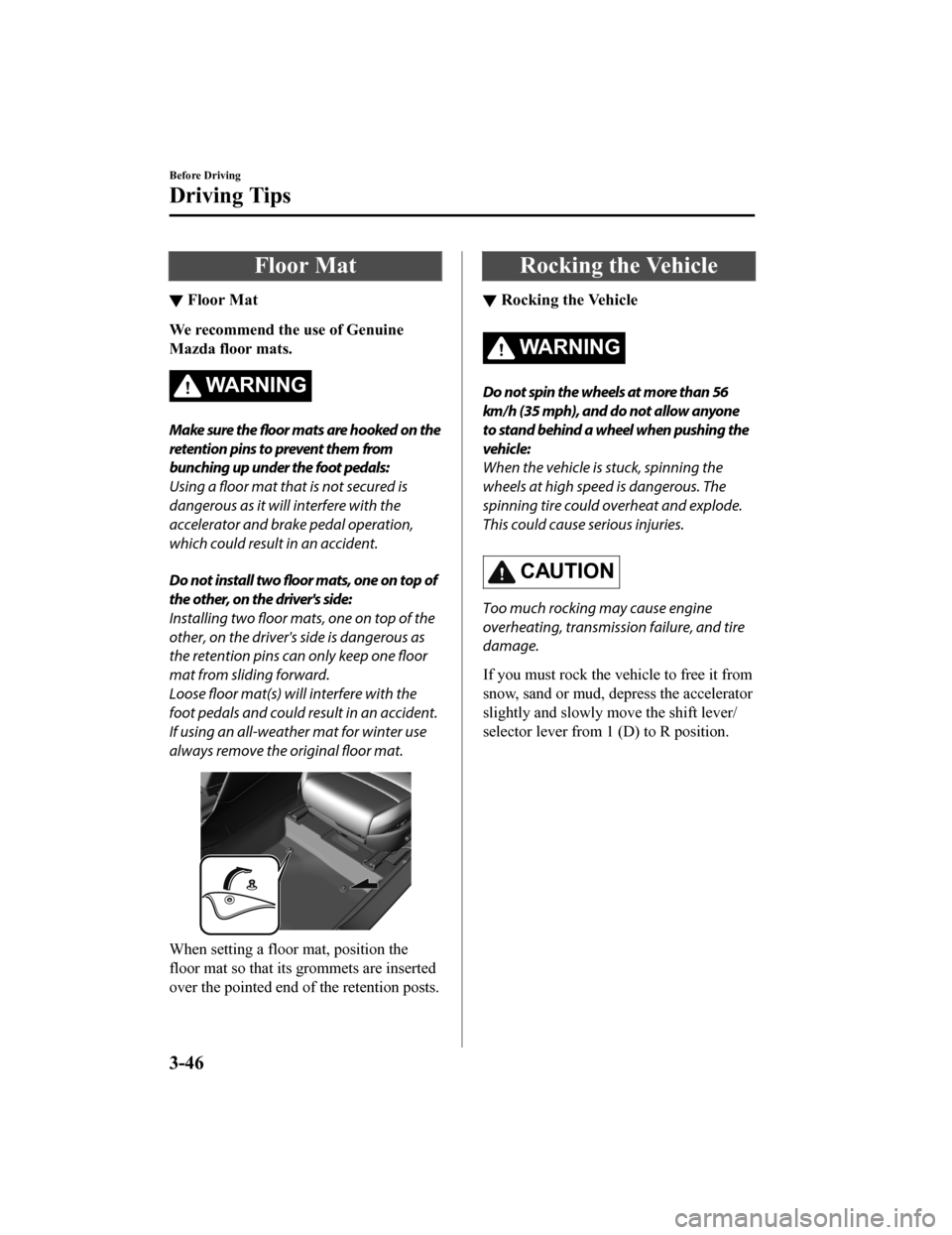
Floor Mat
▼Floor Mat
We recommend the use of Genuine
Mazda floor mats.
WA R N I N G
Make sure the
floor mats are hooked on the
retention pins to prevent them from
bunching up under the foot pedals:
Using a floor mat that is not secured is
dangerous as it will interfere with the
accelerator and brake pedal operation,
which could result in an accident.
Do not install two floor mats, one on top of
the other, on the driver's side:
Installing two floor mats, one on top of the
other, on the driver's side is dangerous as
the retention pins can only keep one floor
mat from sliding forward.
Loose floor mat(s) will interfere with the
foot pedals and could result in an accident.
If using an all-weather mat for winter use
always remove the original floor mat.
When setting a floor mat, position the
floor mat so that its grommets are inserted
over the pointed end of the retention posts.
Rocking the Vehicle
▼Rocking the Vehicle
WA R N I N G
Do not spin the wheels at more than 56
km/h (35 mph), and do not allow anyone
to stand behind a wheel when pushing the
vehicle:
When the vehicle is stuck, spinning the
wheels at high speed is dangerous. The
spinning tire could
overheat and explode.
This could cause serious injuries.
CAUTION
Too much rocking may cause engine
overheating, transmission failure, and tire
damage.
If you must rock the vehicle to free it from
snow, sand or mud, depress the accelerator
slightly and slowly mo ve the shift lever/
selector lever from 1 (D) to R position.
Before Driving
Driving Tips
3-46
Mazda3_8HZ1-EA-19G_Edition1_old 2019-5-17 13:49:03
Page 139 of 598
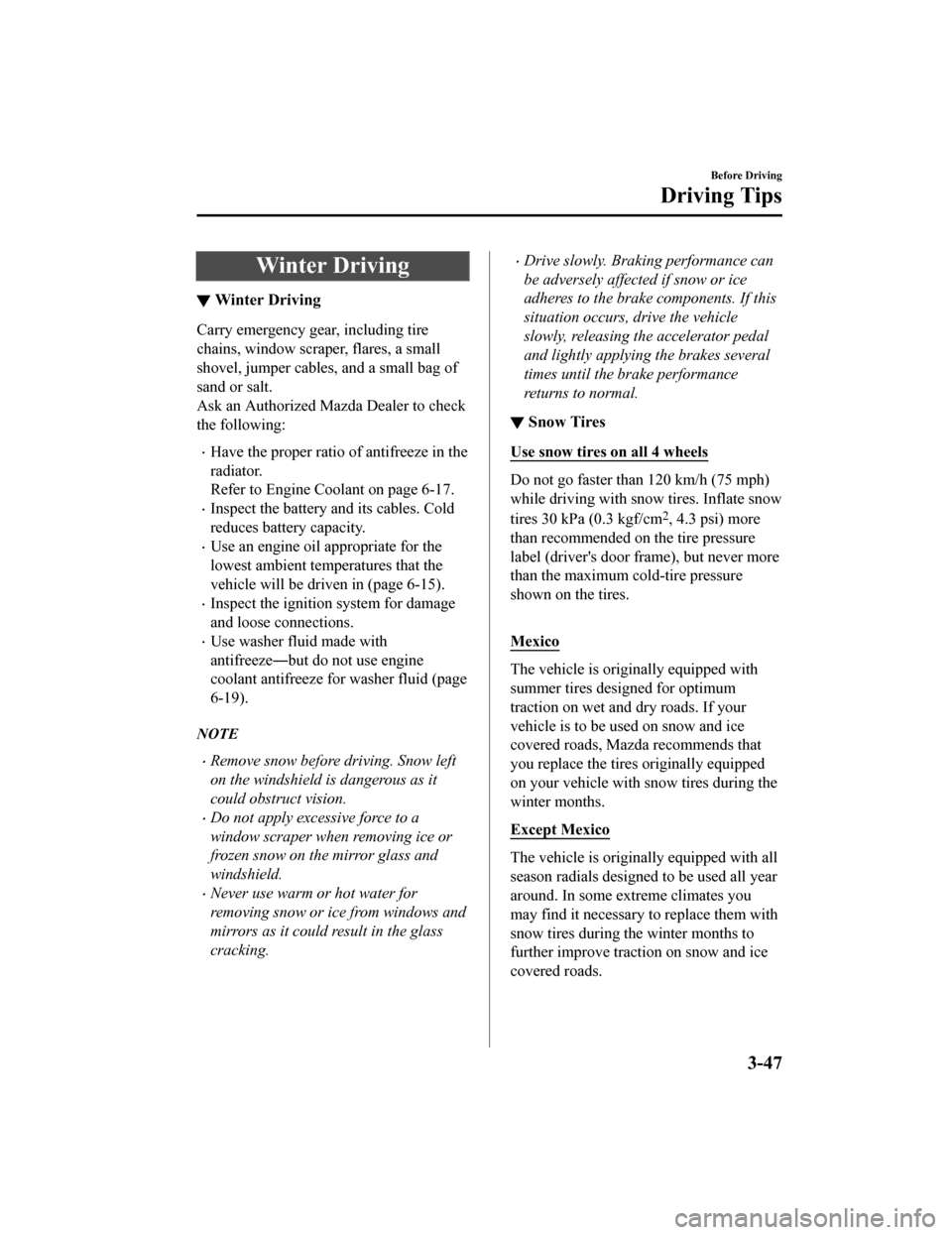
Winter Driving
▼Winter Driving
Carry emergency gear, including tire
chains, window scraper, flares, a small
shovel, jumper cables
, and a small bag of
sand or salt.
Ask an Authorized Maz da Dealer to check
the following:
Have the proper ratio of antifreeze in the
radiator.
Refer to Engine Coolant on page 6-17.
Inspect the ba ttery and its cables. Cold
reduces battery capacity.
Use an engine oil appropriate for the
lowest ambient temperatures that the
vehicle will be driven in (page 6-15).
Inspect the ignition system for damage
and loose connections.
Use washer fluid made with
antifreeze―but do not use engine
coolant antifreeze for washer fluid (page
6-19).
NOTE
Remove snow before driving. Snow left
on the windshield is dangerous as it
could obstruct vision.
Do not apply excessive force to a
window scraper when removing ice or
frozen snow on the mirror glass and
windshield.
Never use warm or hot water for
removing snow or ice from windows and
mirrors as it could result in the glass
cracking.
Drive slowly. Braking performance can
be adversely affected if snow or ice
adheres to the brake components. If this
situation occurs, drive the vehicle
slowly, releasing the accelerator pedal
and lightly applying the brakes several
times until the brake performance
returns to normal.
▼ Snow Tires
Use snow tires on all 4 wheels
Do not go faster than 120 km/h (75 mph)
while driving with snow tires. Inflate snow
tires 30 kPa (0.3 kgf/cm
2, 4.3 psi) more
than recommended on the tire pressure
label (driver's door frame), but never more
than the maximum cold-tire pressure
shown on the tires.
Mexico
The vehicle is origin ally equipped with
summer tires designed for optimum
traction on wet and dry roads. If your
vehicle is to be used on snow and ice
covered roads, Mazda recommends that
you replace the tires originally equipped
on your vehicle with snow tires during the
winter months.
Except Mexico
The vehicle is origina lly equipped with all
season radials designed to be used all year
around. In some extreme climates you
may find it necessary to replace them with
snow tires during the winter months to
further improve traction on snow and ice
covered roads.
Before Driving
Driving Tips
3-47
Mazda3_8HZ1-EA-19G_Edition1_old 2019-5-17 13:49:03